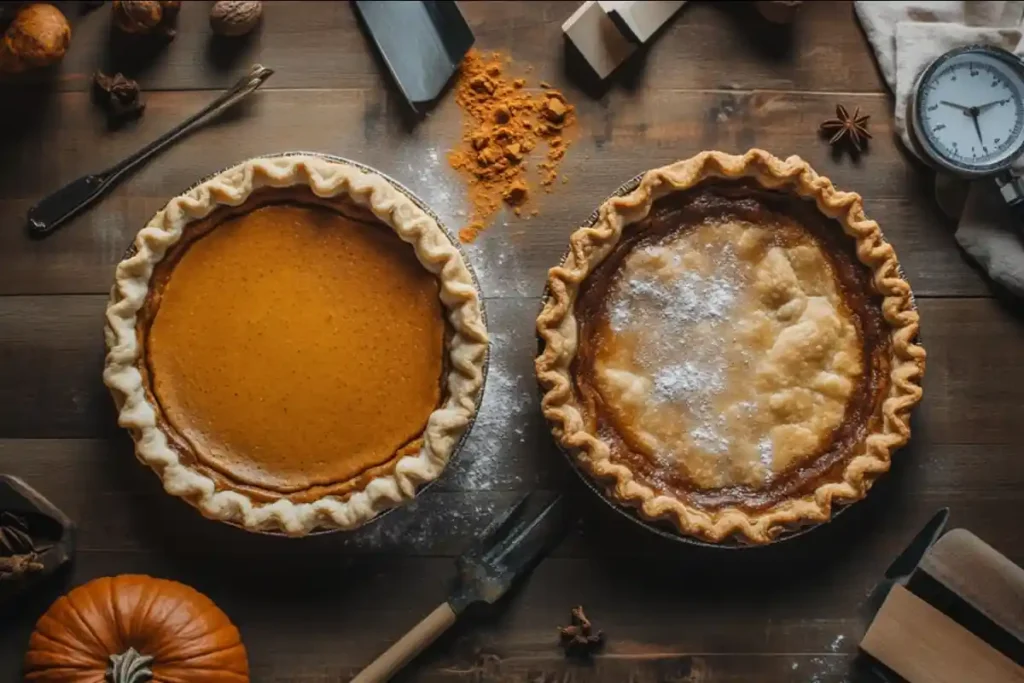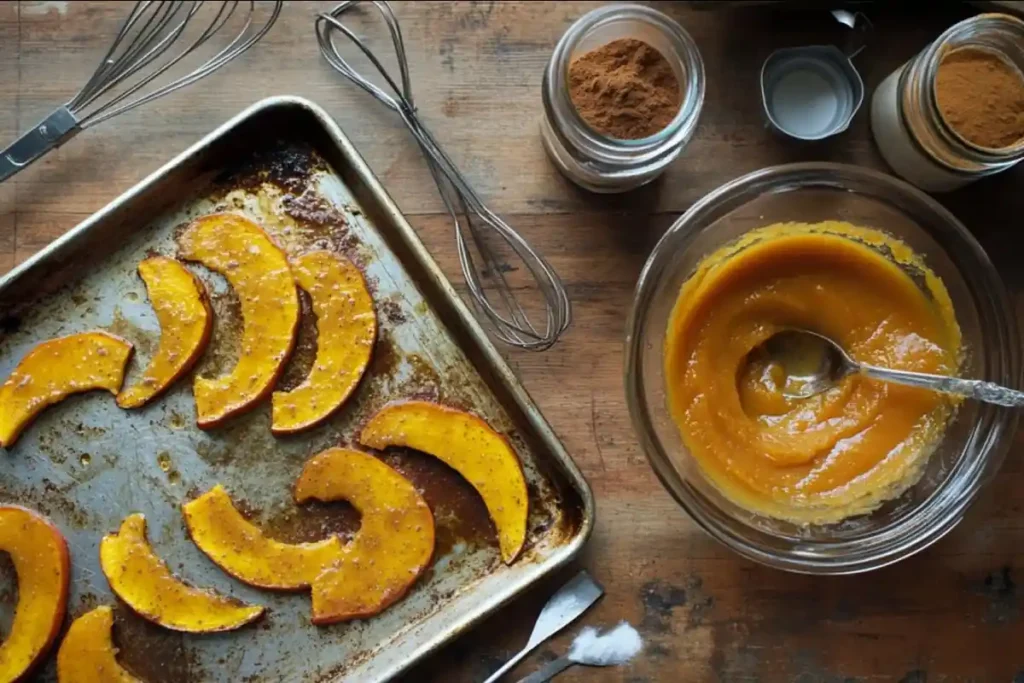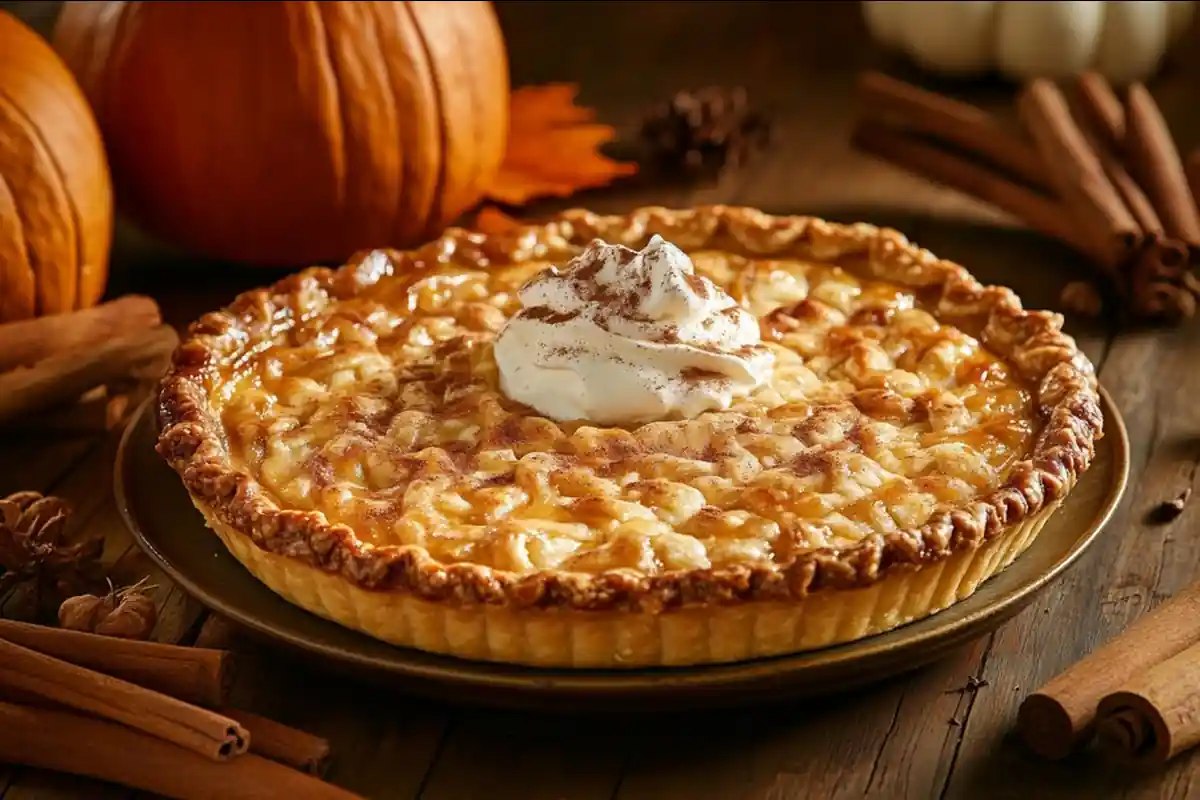Pumpkin pie is a favorite at Thanksgiving and holidays, but have you ever wondered, “Why does my pumpkin pie taste bitter?” This can be upsetting, especially if you made it yourself. Luckily, the reasons for a bitter pie are usually easy to find and fix.
Whether you’re an experienced baker or new to pumpkin pie, knowing why it tastes bitter is key. This guide will cover the main reasons and how to fix them. You’ll learn about ingredients, baking temperature, and more to make your pie perfect.
Key Takeaways
- Pumpkin pie can taste bitter due to factors like the type of pumpkin used, baking methods, and ingredient quality.
- Roasting pumpkins at high temperatures or using certain pumpkin varieties, like Long Island Cheese, can result in a naturally bitter flavor.
- Canned pumpkin puree may be a safer option for consistent flavor, as it is processed to reduce bitterness.
- Proper temperature control and baking techniques, such as blind baking the crust and cooking the pumpkin mixture before assembling the pie, can help prevent bitterness.
- Balancing the spices and sweeteners in the recipe is crucial to achieving the perfect pumpkin pie flavor profile.
Understanding Common Causes of Bitter Pumpkin Pie
Baking the perfect pumpkin pie means knowing why it might taste bitter. Several things, like chemical reactions and the quality of ingredients, can make your pie taste bad.

Chemical Reactions During Baking
Baking can start complex chemical reactions that affect your pie’s taste. For example, sugar caramelizing and the Maillard reaction can create bitter flavors if the pie is overcooked or baked too hot.
Quality of Ingredients Impact
The ingredients you use are key to a good pumpkin pie. A bad pumpkin or old spices can make your pie taste bitter. Always choose fresh, high-quality ingredients for the best taste.
Temperature Control Issues
Keeping the right temperature while baking is vital. If the pie is too hot or too long in the oven, it can taste bitter. Make sure to bake it at the right temperature and for the right time for the best taste and texture.
Knowing why pumpkin pies can taste bitter helps you avoid these problems. This way, you can make a delicious pie that everyone will love.
Selecting the Right Pumpkin Variety for Pie Making
Choosing the right pumpkin is key for a perfect pie. Not all pumpkins taste good in pies. Look for ones labeled for baking or pie-making.
The New England Pie pumpkin is a top pick. It’s small to medium and has a deep orange color. The Baby Pam Sugar Pie is also great, known for its size and flavor.
Heirloom varieties like Winter Luxury have old-fashioned flavors. But, they might not yield much. The Mystique, a small pie pumpkin, is better for gardeners because it yields fairly well.
The Kabocha pumpkin adds an exotic twist with its dark green skin and sweet taste. The Snow White pumpkin has a white skin but red-orange flesh, offering a unique flavor.
For a consistent taste, canned pumpkin puree is a good choice. Libby’s 100% pure pumpkin is a reliable option. It ensures a uniform flavor without the guesswork of fresh pumpkins.
Always pick pumpkins labeled for baking or pie-making. Some, like the Long Island Cheese pumpkin, can be bitter. By choosing the right pumpkin, you’ll make a delicious pie that everyone will love.
The Role of Spices in Pumpkin Pie Flavor
Spices are key to making pumpkin pie taste great. The mix usually includes cinnamon, ginger, cloves, and nutmeg. These spices together give pumpkin pie its unique taste, loved during Thanksgiving and holidays.
Balancing Traditional Spice Measurements
Getting the spice mix right is important for a good pumpkin pie. Too much of any spice can make the pie taste bad. Our research shows that using less sugar can make the pumpkin taste better, but too much sugar can make the pie look weird.
Common Spice Mistakes to Avoid
Using too much spice, especially cloves or nutmeg, can make the pie taste bitter. It’s best to stick to the recipe and add spices carefully. Swapping pumpkin pie spice for individual spices can change the texture, making it too soft.
Impact of Over-Spicing
Too many spices can ruin a pumpkin pie’s taste and feel. Adding an extra egg made the pie too cake-like. Not using eggs made it too runny with a thick orange skin.
Knowing how to use spices right helps make a great pumpkin pie. It’s a treat that captures the warm, rich flavors of the holiday season.
“Pumpkin spice can be dated back to the Dutch East India Company in the 1600s, and the first known American cookbook in 1796 included a pumpkin pie recipe with a blend of mace, nutmeg, and ginger.”
Why Does My Pumpkin Pie Taste Bitter?
If your homemade pumpkin pie tastes bitter, you’re not alone. Bitterness can come from different sources like the pumpkin type, spices, and cooking method. Knowing why your pie tastes bitter helps you fix it. You can make your pie sweet and creamy again.
Pumpkin Variety and Quality
The pumpkin you choose affects your pie’s taste. Sugar pumpkins or Cinderella pumpkins are best for baking. A low-quality or old pumpkin can make your pie taste bad. Pick the right pumpkin and use it when it’s fresh.
Spice Blend Imbalance
Spices like cinnamon, ginger, and nutmeg are key in pumpkin pie. But, too much can make it bitter. Check your recipe’s spice amounts and adjust them to your liking.
Overcooking and Temperature Issues
Pumpkin pie is delicate. Overcooking or wrong temperatures can make it bitter. The FDA says the pie should be at least 180°F. Baking too long or too hot can ruin the taste.
By knowing why your pie tastes bitter and adjusting your recipe and baking, you can make a delicious pie. Your family and guests will love it.
| Canned Pumpkin Purée Brand | Price Range | Tasting Notes |
|---|---|---|
| 365 Organic by Whole Foods Market | $2.29 | Positive reviews from all tasters, well-received |
| Libby’s | $1.39 | Traditionally popular, but did not fare well in the taste test |
| Wholesome Pantry by ShopRite | $1.99 | Well-received, organic product |
| Farmer’s Market | $3.29 | Well-received, organic product |
Proper Pumpkin Preparation Techniques
Making the perfect pumpkin pie begins with how you prepare the pumpkin. Whether you choose fresh or canned pumpkin, the details matter. These steps will help your pumpkin recipes be delicious.
Roasting Methods
Roasting fresh pumpkin brings out its sweetness and adds depth to the flavor. But, it’s vital to get the temperature and time right. Roasting at 375°F for 45 minutes might make it taste bitter.
Try roasting at 400°F for 30-40 minutes for a better taste. Always watch the pumpkin closely and check if it’s done.
Puree Consistency Guidelines

Getting the pumpkin puree just right is crucial for a smooth pie filling. It should be silky and without lumps. Blend the roasted pumpkin until it’s smooth.
If it’s too thin, simmer it to remove excess moisture. If it’s too thick, add a bit of water or milk to thin it.
Canned pumpkin puree is also a good choice. About 61% of people find it easier to use canned. Just cook it on the stove for a few minutes to enhance its taste and texture.
“Properly preparing the pumpkin is the foundation for a delectable pumpkin pie. Pay attention to those roasting temperatures and puree consistency, and you’ll be on your way to baking perfection.”
The Importance of Sweeteners and Their Proportions
Choosing the right sweeteners is key to baking a delicious pumpkin pie flavor. Sweeteners help balance the taste, making sure the pumpkin is not too bland or sweet. They also prevent the sweetness from drowning out the other spices.
Sweetened condensed milk is a favorite for adding sweetness. It makes the filling denser and creamier, enhancing the holiday baking experience. But, it’s crucial to use it in the right amount to keep the pumpkin flavor in check.
White sugar is common, but there are other options too. Baking tips suggest trying brown sugar, honey, maple syrup, or fruit juice concentrates. Each sweetener brings a unique taste that can enhance the pumpkin in its own way.
| Sweetener | Sweetness Compared to Sugar | Recommended Substitution Ratio |
|---|---|---|
| Honey | 25-50% sweeter than sugar | Use 1 1/3 cups honey for 1 cup sugar |
| Maple Syrup | 60% as sweet as sugar | Use 1 cup maple syrup for 1 cup sugar |
| Molasses | Not as sweet as sugar | Use 1 1/3 cups molasses for 1 cup sugar |
| Fructose | Sweeter than granulated sugar | Use 2/3 cup fructose for 1 cup sugar |
| Brown Rice Malt Syrup | Similar sweetness to sugar | Use 1 cup syrup for 1 cup sugar, reduce other liquids by 1/4 cup |
When trying out different sweeteners, it’s vital to adjust the amounts carefully. This ensures the pumpkin pie flavor is just right, not too sweet. By finding the perfect balance, you’ll create a holiday dessert that everyone will love.
Fresh vs. Canned Pumpkin: Impact on Taste
Choosing between fresh and canned pumpkin puree can change your pumpkin recipes’ taste and texture. Canned pumpkin, like Libby’s, is easy and consistent. But fresh pumpkin offers a more vibrant and complex taste.
Storage and Freshness Factors
Fresh pumpkin needs the right storage to keep its flavor and moisture. It can spoil quickly if not stored properly. Canned pumpkin, however, lasts longer and stays fresh, making it great for baking all year.
Processing Methods Comparison
Canned pumpkin is cooked and canned in a standard way, ensuring consistency. Fresh pumpkin puree is made by roasting or steaming the pumpkin before blending. This makes fresh pumpkin taste more robust and earthy compared to canned pumpkin’s creamy sweetness.
In a pumpkin bread recipe test, canned and fresh pumpkin were compared. The canned pumpkin was thicker and darker, but fresh needed an extra hour to bake. Yet, taste tests showed no big difference. This means canned pumpkin can often be a good substitute for fresh, offering a tasty result.
But, if you want to try new flavors or control your recipe more, fresh pumpkin is worth it. You can add spices, use different squash types, or roast the pumpkin for a richer taste. This way, you can make unique pumpkin recipes that show off the ingredient’s versatility.
Dairy Ingredients and Their Effect on Flavor
Dairy ingredients are key in making a pumpkin pie taste great. The type of milk used can change the pie’s flavor and texture. For example, sweetened condensed milk makes the pie creamy and a bit sweet. Evaporated milk, on the other hand, makes it lighter and fluffier.
Using the wrong milk can mess up the pie’s taste and feel. Swapping sweetened condensed milk for evaporated milk can make it too sweet. It’s important to pick the right dairy ingredients and mix them just right to get the flavor and texture you want.
| Dairy Ingredient | Effect on Pumpkin Pie Flavor |
|---|---|
| Sweetened Condensed Milk | Adds richness and creaminess, enhances sweetness |
| Evaporated Milk | Creates a lighter, more airy texture |
| Whole Milk | Provides a balanced, traditional pumpkin pie flavor |
| Low-Fat or Skim Milk | May result in a less creamy, more watery filling |
Knowing how different milks affect a pumpkin pie can help bakers make better choices. Trying out different milks and amounts can reveal new flavors in this classic dessert. It’s all about finding the right mix for your Thanksgiving dessert.
Common Baking Mistakes That Cause Bitterness
Making the perfect pumpkin pie is a delicate task. Even a small mistake can make it bitter and unappetizing. It’s important to know and avoid common baking errors to get that rich, creamy flavor you want in your holiday pie.
Temperature Control Issues
One big mistake is overcooking the pie. Baking it too hot can make it cook unevenly, leading to a tough, bitter taste. The best temperature for baking a pumpkin pie is around 350°F (175°C). This ensures it stays creamy without getting overcooked.
Timing and Doneness Indicators
Getting the timing right and knowing when it’s done are key to avoiding bitterness. Overbaking can make the custard curdle and taste bitter. Use a knife or toothpick to check if the center is firm. Also, let the pie cool completely before serving for the best taste and texture.
By keeping the temperature steady, watching the time, and checking for doneness, you can make a pie that’s perfectly balanced and free of bitterness. With a bit of care, your holiday dessert will be a hit with your guests.
| Common Baking Mistakes | Percentage of Occurrence |
|---|---|
| Too salty | 1 in 15 |
| Too sour | 2 in 15 |
| Too tart | 1 in 15 |
| Too sweet | 1 in 15 |
| Bitter flavor | 1 in 15 |
| Bland | 1 in 15 |
| Too spicy | 1 in 15 |
| Sear not achieved on meat | 1 in 15 |
| No browning on sautéed food | 1 in 15 |
| Overcooked pasta | 1 in 15 |
| Undercooked pasta | 1 in 15 |
| Undercooked roast | 1 in 15 |
| Soggy fries | 1 in 15 |
| Lumpy sauce or gravy | 1 in 15 |
By knowing and avoiding these common mistakes, you can make your holiday pumpkin pie a success. It will be a delightful treat for your guests, free from bitterness.
FAQ
Why does my pumpkin pie taste bitter?
Pumpkin pie can taste bitter for many reasons. It could be the pumpkin type, baking methods, or the quality of ingredients. Making sure to prepare well, control the temperature, and choose the right ingredients is key to a great taste.
What causes the bitter taste in pumpkin pie?
Bitterness in pumpkin pie can come from several sources. Chemical reactions, low-quality ingredients, and temperature issues are common culprits. Too much of strong spices like cloves or nutmeg can also make it bitter.
How do I choose the right pumpkin variety for pie making?
Not all pumpkins are good for pie. Some, like the Long Island Cheese pumpkin, might taste bitter. It’s best to pick pumpkins labeled for baking or pie-making. Canned pumpkin puree is a good alternative for consistent taste.
What role do spices play in pumpkin pie flavor?
Spices like cinnamon, ginger, cloves, and nutmeg are vital for the pie’s flavor. But, too much of strong spices can make it bitter. Finding the right balance is essential for a great taste.
How do I avoid a bitter aftertaste in my pumpkin pie?
Several factors can cause bitterness in pumpkin pie. The pumpkin type, cooking methods, and ingredient amounts are important. Avoiding too much spice, not overcooking, and using quality ingredients can prevent bitterness.
What’s the best way to prepare the pumpkin for pie making?
Preparing the pumpkin right is key for a tasty pie. Roasting at 375°F for 45 minutes might make it bitter. Adjusting the time and temperature can help. Also, making sure the pumpkin puree is smooth is important for the pie’s texture.
How do sweeteners affect the flavor of pumpkin pie?
Sweeteners are crucial for balancing the pie’s flavors. Too little sugar can make it taste bland or bitter. Too much can overpower the pumpkin. Sweetened condensed milk adds a rich sweetness.
What’s the difference between using fresh pumpkin and canned pumpkin puree?
Fresh and canned pumpkin puree can give different results. Canned pumpkin, like Libby’s, offers consistent flavor and texture. Fresh pumpkin’s taste and moisture can vary. Storing fresh pumpkin properly is important for its flavor.
How do dairy ingredients impact pumpkin pie flavor and texture?
Dairy ingredients greatly affect the pie’s flavor and texture. Sweetened condensed milk adds richness and creaminess. Evaporated milk makes it lighter. The wrong milk can change the sweetness and texture, affecting the flavor.
What are common baking mistakes that can lead to a bitter pumpkin pie?
Overcooking, temperature issues, and timing problems can make the pie bitter. Baking too hot can cause uneven cooking, leading to bitterness and a bad texture. Paying attention to visual cues and using the knife test can help get it right.
Conclusion
Making the perfect pumpkin pie flavor for your Thanksgiving dessert or holiday baking is all about balance. It’s about the right mix of ingredients, how you prepare them, and the baking details. Even beginners can make a delicious pumpkin pie by avoiding bitterness.
Choosing the right pumpkin and the right amount of sweeteners and spices is key. Each step in making the pie is important for the taste and texture. Whether using fresh or canned pumpkin, quality is crucial. Stick to recipes to avoid problems during baking.
This guide helps bakers make pumpkin pie with confidence. They can create a dessert that captures the autumn season’s essence. By paying attention to ingredient selection and preparation, home cooks can make their pumpkin pie flavor stand out. Their Thanksgiving dessert or holiday baking will be a true success.


3 thoughts on “Why Does My Pumpkin Pie Taste Bitter?”